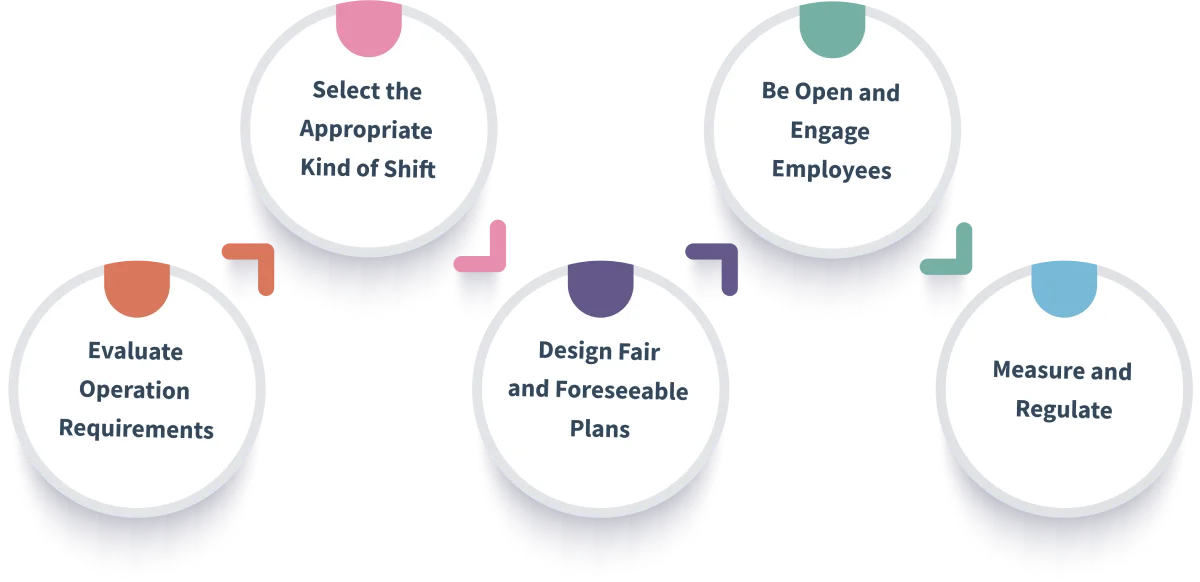What is Shift Work? Types, Examples, Pros, Cons, and Managing Tips
Shift work has made industries operate throughout the day and night and has made businesses continue their operations even outside the 9-5. Whether it is customer service and healthcare, manufacturing and security, or any other field, the most crucial roles are covered by shift work 24 hours a day. Nonetheless, shift schedules are difficult to manage, since they have to balance the health of employees, justice, and productivity.
This blog will give us an idea of what shift work is, the various shift work schedules, and examples of shift work in real life. You will know how to operate an employee a shift schedule, learn the pros and cons of the shift schedules, and receive tips on how to handle some of the problems that usually arise. When properly done, shift work can be beneficial to operations and the staff.
What is Shift Work?
Shift work refers to the work schedule in which the employees work non-conventional shifts, and cover early morning, evening, overnight, or rotating shifts to keep the business running continuously outside the typical 9-to-5 working hours.
The shift work makes sure that even when the usual hours are over, services and production lines are running fine. Shift work is to satisfy the needs of the customers , deliver indispensable services, and rationalize the use of labor at all times.
Shift work schedules enhance responsiveness and accessibility in industries such as healthcare, retail, and logistics. Although required to perform non-stop, rotated shifts may affect sleep, social schedule, and health. Knowledge of such effects assists organizations in developing equitable, viable schedules.
What are the Different Types of Work Shifts?
There is a variety of shift work that suits specific functional requirements:
1. Vision & Objectives The workers are on the same schedule, e.g., 8 am to 4 pm or 3 pm to 11 pm.
2. Rotating shift work: Employees alternate between working day, evening, and night shifts on a pre-determined cycle.
3. Split shifts: Breaking up the workday into alternating blocks, e.g., 8.00 to 11.00 am and 2.00 to 5.00 pm.
4. Seasonal or irregular changes: Changes to the schedule are made according to demand, such as during holidays , retail, or fluctuating schedules.
5. Long shifts: 12-hour rotations with several days on/off, such as the DuPont or Pitman systems.
What are the Examples of Shift Work?

Find out about typical examples of shift work at work:
- First Shift: Daytime hours (e.g., 7 am–3 pm) in retail, HR, or customer support.
- Second (swing) Shift: Afternoon to late evening (e.g., 3 pm–11 pm).
- Third (night/graveyard) Shift: Overnight hours (e.g., midnight–8 am) are critical in hospitals, manufacturing, and IT.
- Rotating Shift: A rotating cycle where a team works days during the week, evenings the next, then nights.
- Split Shift Example: The people in the restaurant work during breakfast and come back during dinner.
- DuPont Rotated: 4 weekdays & nights with rest periods.
- Pitman Schedule: 4-week cycle; shifts alternate every two weeks.
These shift work examples are actual practices of maintaining operations around the clock with the goal of an equal workload.
How to Manage a Shift Work Schedule?

To ensure productivity in the workforce , satisfaction of the workforce, and 24/7 business, it is important to manage the shift work schedule effectively. That is the way to do the right thing:
1. Evaluate Operation Requirements
Start by examining the need for staff coverage by time and location. Research historical data to find out the peak hours, seasonal changes, and the needs of a department. It will assist you in establishing the number of employees to work at each shift and the kind of rotation that will work the best.
2. Select the Appropriate Kind of Shift
Choose between fixed, rotating, split, or compressed shifts depending on your industry. As an example, a factory can enjoy the advantages of rotating shifts, whereas a 24-hour call center may require regular day and night shifts.
3. Design Fair and Foreseeable Plans
An employee shift schedule should be well-balanced, and there should be a fair sharing of night shifts, weekend shifts, and holiday shifts. Visualize workloads using digital scheduling tools to reduce last-minute changes, which frustrates staff.
4. Be Open and Engage Employees
Post timetables beforehand and enable workers to trade shifts or preferences where feasible. Feedback from employees decreases burnout and increases morale .
5. Measure and Regulate
Monitor performance , absenteeism, and employee feedback continuously . Streamline your shift work schedules so that they remain efficient and people-friendly in the long run.
What are the Advantages of Shift Work?
There are a lot of advantages to shift work:
- There are always coverage of 24/7 operations.
- Work flexibility for employees who require evening or night shifts.
- High earnings = unsocial shift premium pay.
- Better utilization of resources- machines and facilities operate round the clock.
- Improves work-life balance by selecting a few off-peak leisure time activities.
Research indicates that shift work is carried out by 15-20 percent of employees in industrialized nations; this demonstrates the wide scope of shift work.
What are the Disadvantages of Shift Work?
The shift work has its disadvantages too:
- Working abnormal hours may cause disorders in sleep patterns and an increased risk of getting diseases.
- Family and social stress due to off-hours can conflict with normal schedules.
- Stress and tiredness, particularly when it comes to alternating shifts.
- The error rates have increased on night shifts because of the lack of alertness.
- A case of confusion in scheduling occurs when it is not well planned.
These should be kept in mind in any shift work schedule as they are important in protecting the well-being of employees.
How to Overcome the Challenges of Shift Work?
Address the following strategies to overcome shift work:
1. Use predictable schedules like rotating patterns with rest periods (e.g., DuPont or 2-2-3).
2. Assists workers in adapting through sleep hygiene training and health support.
3. Seek opinion-question employees to get to the problem areas and time conflicts.
4. Make sure that there is legal compliance with breaks, overtime limits , and rest periods.
5. Offer shift differentials, benefits, or wellness opportunities to counter difficult work schedules.
6. Use technology such as automated scheduling software to streamline rota and eliminate mistakes.
These measures contribute to the well-being of personnel, their contentment, and performance uniformity.

